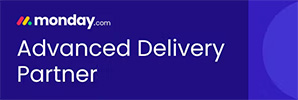I’d like to spend some time to have a discussion around the difference between resource allocation and task assignment. This is a topic that I don’t think gets enough attention because of the similarities of the two concepts they often get confused. This confusion just leads to an exercise in futility. As a result people use the wrong concepts to try to manage utilization. I have briefly touched on this topic before, most recently, I highlighted the usage differences at the 2023 monday.com Elevate conference, in a masterclass presentation.
To provide a little bit of backstory, as well as illuminate these concepts, I want to share a recent conversation I had with a customer around utilization dashboards and how they wanted to leverage timesheet data to report utilization as a key KPI. This customer manages a creative process so their plans don’t give them the best sense of utilization.
As we all know, creative is very hard to plan around. Unlike straightforward tasks such as painting a room, which might take 4 to 8 hours, creative projects can range from 1 hour to a 100. The variability of creative work makes task-level planning impractical. I will cover this further in another blog, so stay tuned….
In any case, the customer was only looking at the data they had, which in this case, was timesheets. Their goal was to build dashboards as a way to measure team utilization. Their complaint was – it just didn’t seem to work, and they wanted my help to build a better dashboard. In their mind, if they could follow a simple equation to determine who was over utilized, and who was under utilized, based on past projects that were similar in nature.
My response was an immediate, “You can’t get better because you are limiting yourself to timesheets; relying solely on past occurrences for future planning is akin to steering a car with only a rear-view mirror – (an ineffective strategy) – and you are not going to have a good time”.
Now, this client is not alone, I have seen this with other organizations. Creative endeavors fluctuate widely in duration, making task-level planning untenable. What you need is the inverse of timesheets, enter into the discussion: resource allocation.
Resource allocation can be thought of as future timesheets; it’s basically a timesheet where you predict at a high level only – what you will work on and when; as opposed to what you did work on. When you think about it this way. It really helps to frame the discussion around utilization and resource planning.
As the President of a services company, my product (people’s time) is the definition of a zero-shelf-life product. (I stole this line from my old mentor and CEO, John Dreyer). Once the time has passed, it’s gone and can never be used again. I can’t say, “Oh it looks like you were idle for 20 hours last week let’s use those 20 hrs this week”. Trust me, I wish it worked that way, but it doesn’t. That means if we find out that someone was not utilized in a timesheet, it’s too late! There is nothing we can do to change that — short of finding a flux capacitor or something that allows time travel.
Instead, we need to be proactive, as managers, we need to ask our team to effectively pre-fill their expected timesheets for upcoming weeks to let us know what they are working on and what the demands are on their time. This in turn, allows us to create dashboards, that show us gaps in utilization; and since it is in the future, we have time to actually address these gaps (no flux capacitor needed). This is the primary principal behind the concept of resource allocation and what makes it such a powerful tool.
That being all said, every manager has experienced the pushback of their team, they can’t predict the future and that’s why the exercise of resource allocation is a futile effort. To which I respond there are lots of different tactics and strategies to manage forward looking plans. Several industries have adeptly tackled this challenge, providing valuable insights and approaches that can be applied across diverse sectors. This forward-looking methodology aligns with successful models found in industries such as hospitality and airlines, where intricate planning ensures optimal resource utilization. I’ll cover change management strategies in a subsequent posting, so stay tuned…
By now, you might be thinking “John, what about task assignment?” Okay, lets talk about the difference.
To start we can all agree, a detailed plan with resource assignment, timeline, and effort estimates can be broken down to answer the following questions:
- What project is a resource is working on?
- How long did they work on it?
- When did they work on it?
While resource allocation focuses on predicting the future, task assignment operates at a more granular level, outlining specific responsibilities, timelines, and effort estimates. This can give the perception of perfect planning. Perfect being the operative word. There are 2 major problems with using task assignments as resource plans:
- Plans that tend to be overly precise or perfect, often times leads to complications when schedules shift or tasks are reassigned. For example, if I have a task that calls for 10 hours over 3 days am I really working 3.3 hours exactly each day? What happens if the plan changes and everything gets shuffled around? In a shared resource environment, that becomes unmanageable. Imagine we had a plan that tracked the demand perfectly for a particular week; they needed 30 hours and the following week they needed only 10 hours. Because of those assumptions, other plans were made to fill the 10 and 30 availability. What happens when the plan changes and the demand curve shifts by a week? It plays havoc with other plans and projects. It’s effectively unmanageable
- People need regularity, predictability, and most importantly manageable blocks of time they can reserve their lives around. Human like predictable and cyclical work patterns. Plans that are weird or overly precise are inherently variable, making it impractical to action. The task assignment model requires us to schedule our time in often weird planning logic that only makes sense to a plan optimizer. A great example is my sister, who has worked as a night shift nurse in the ICU for the last 10 years. She absolutely hates it when her schedule gets changed and she is randomly called to work an odd shift on her day off. Or just ask anyone who has has to manage a restaurant – they will tell you that employees don’t like to be scheduled to work random blocks of hours. We humans like to think, and live, in blocks of time.

This is why task assignment doesn’t really work as a form of resource allocation. It can serve as an input, a demand signal for us to better plan resource allocations, but it can’t be the allocation. The crazy thing is, most organizations do separate it, they just don’t formalize it, and as a result, they don’t realize and manage it actively but still pay for the overhead associated with managing resource allocation.
For high-performing organizations where utilization is a key performance indicator, the separation of resource allocation and task assignment is paramount. A keen observer will realized that a planning at the task level, effectively is a form of predicting the future and can be thought of as an input to resource allocation. While task assignments can serve as inputs for resource planning, they should not be mistaken for the allocation itself. This clear distinction enables organizations to actively manage and optimize resource utilization, fostering predictability and regularity for team members. This will increase your ability to pivot at a moments notice without the chaos of managing a schedule change. Make sense?
By embracing forward-looking resource allocation, all our customers’s businesses can navigate the landscape of project management with precision and foresight, ultimately achieving success. More importantly like the customer I mentioned above, it will give you the most accurate overview in determining your teams utilization, which will allow you to take on more business, ensures employee retention, satisfaction, and empowerment.
Want a Resource Allocation Demo- Schedule one here.
Don’t forget to follow us on LinkedIn for tips and tricks to enhance your monday experience!
Not on monday.com? We would love to invite you to a free trial- click here to get started today!
Just want help? Talk to an expert, click here to schedule a consultation today.
About the authors:
John Hu, is the founder of AXANEXA, as former monday.com customer he learned early on how adapting a flexible platform to solve daily business solutions, can be a transformative experience, and help eliminate wasted back office operations, and help focus on your bottomline.
Partners:






